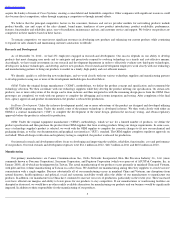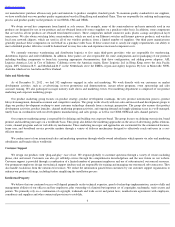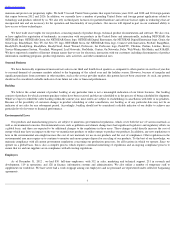Netgear 2012 Annual Report Download - page 19
Download and view the complete annual report
Please find page 19 of the 2012 Netgear annual report below. You can navigate through the pages in the report by either clicking on the pages listed below, or by using the keyword search tool below to find specific information within the annual report.
Table of Contents
If we are unable to obtain a sufficient supply of components, or if we experience any interruption in the supply of components, our product
shipments could be reduced or delayed or our cost of obtaining these components may increase. Component shortages and delays affect our ability to
meet scheduled product deliveries, damage our brand and reputation in the market, and cause us to lose sales and market share. For example,
component shortages and disruptions in supply in the past have limited our ability to supply all the worldwide demand for our products and our
revenue was affected.
Another example relates to the record flooding in Thailand in the third quarter of 2011. Many major manufacturers of hard disk drives and their
component suppliers maintain significant operations in Thailand in areas affected by the flooding. These include most, if not all, of our direct and
indirect suppliers of hard disk drives for our ReadyNAS product line. All of our major direct and indirect suppliers of hard disk drives informed us
that our supply chain would be constrained for an indefinite amount of time, in some cases up to six months. Some therefore declared a force majeure
event and have stated that, in addition to and because of the supply constraints, pricing for hard disk drives would increase significantly until they
were able to stabilize the situation. As a result, we experienced increased prices in the cost of hard disk drives and ceased accepting any additional
orders containing ReadyNAS products with hard disk drives at then current prices and all shipments of ReadyNAS products with hard disk drives
were placed on hold. In addition, all sales and marketing promotions involving ReadyNAS products were terminated temporarily. Further, we
declared the existence of a force majeure event under our contracts with certain customers. Accordingly, our business was harmed. Certain events or
natural disasters that occur in the future may harm our business as well.
If we do not effectively manage our sales channel inventory and product mix, we may incur costs associated with excess inventory, or lose
sales from having too few products.
If we are unable to properly monitor, control and manage our sales channel inventory and maintain an appropriate level and mix of products
with our wholesale distributors and within our sales channels, we may incur increased and unexpected costs associated with this inventory. We
generally allow wholesale distributors and traditional retailers to return a limited amount of our products in exchange for other products. Under our
price protection policy, if we reduce the list price of a product, we are often required to issue a credit in an amount equal to the reduction for each of
the products held in inventory by our wholesale distributors and retailers. If our wholesale distributors and retailers are unable to sell their inventory
in a timely manner, we might lower the price of the products, or these parties may exchange the products for newer products. Also, during the
transition from an existing product to a new replacement product, we must accurately predict the demand for the existing and the new product.
We determine production levels based on our forecasts of demand for our products. Actual demand for our products depends on many factors,
which makes it difficult to forecast. We have experienced differences between our actual and our forecasted demand in the past and expect
differences to arise in the future. If we improperly forecast demand for our products we could end up with too many products and be unable to sell
the excess inventory in a timely manner, if at all, or, alternatively we could end up with too few products and not be able to satisfy demand. This
problem is exacerbated because we attempt to closely match inventory levels with product demand leaving limited margin for error. If these events
occur, we could incur increased expenses associated with writing off excessive or obsolete inventory, lose sales, incur penalties for late delivery or
have to ship products by air freight to meet immediate demand incurring incremental freight costs above the sea freight costs, a preferred method,
and suffering a corresponding decline in gross margins.
If we lose the services of our Chairman and Chief Executive Officer, Patrick C.S. Lo, or our other key personnel, we may not be able to
execute our business strategy effectively.
Our future success depends in large part upon the continued services of our key technical, sales, marketing, finance and senior management
personnel. In particular, the services of Patrick C.S. Lo, our Chairman and Chief Executive Officer, who has led our company since its inception, are
very important to our business. We do not maintain any key person life insurance policies. Our business model requires extremely skilled and
experienced senior management who are able to withstand the rigorous requirements and expectations of our business. Our success depends on senior
management being able to execute at a very high level. The loss of any of our senior management or other key research, development, sales or
marketing personnel, particularly if lost to competitors, could harm our ability to implement our business strategy and respond to the rapidly
changing needs of our business. While we have adopted an emergency succession plan for the short term, we have not formally adopted a long term
succession plan. As a result, if we suffer the loss of services of any key executive, our long term business results may be harmed. While we believe
that we have mitigated some of the business execution and business continuity risk with our recent reorganization into three business units, the loss of
any key personnel would still be disruptive and harm our business, especially given that our business is leanly staffed and relies on the expertise and
high performance of our key personnel. In addition, because we do not have a formal long term succession plan, we may not be able to have the
proper personnel in place to effectively execute our long term business strategy if Patrick Lo or other key personnel retire, resign or are otherwise
terminated.
15
























